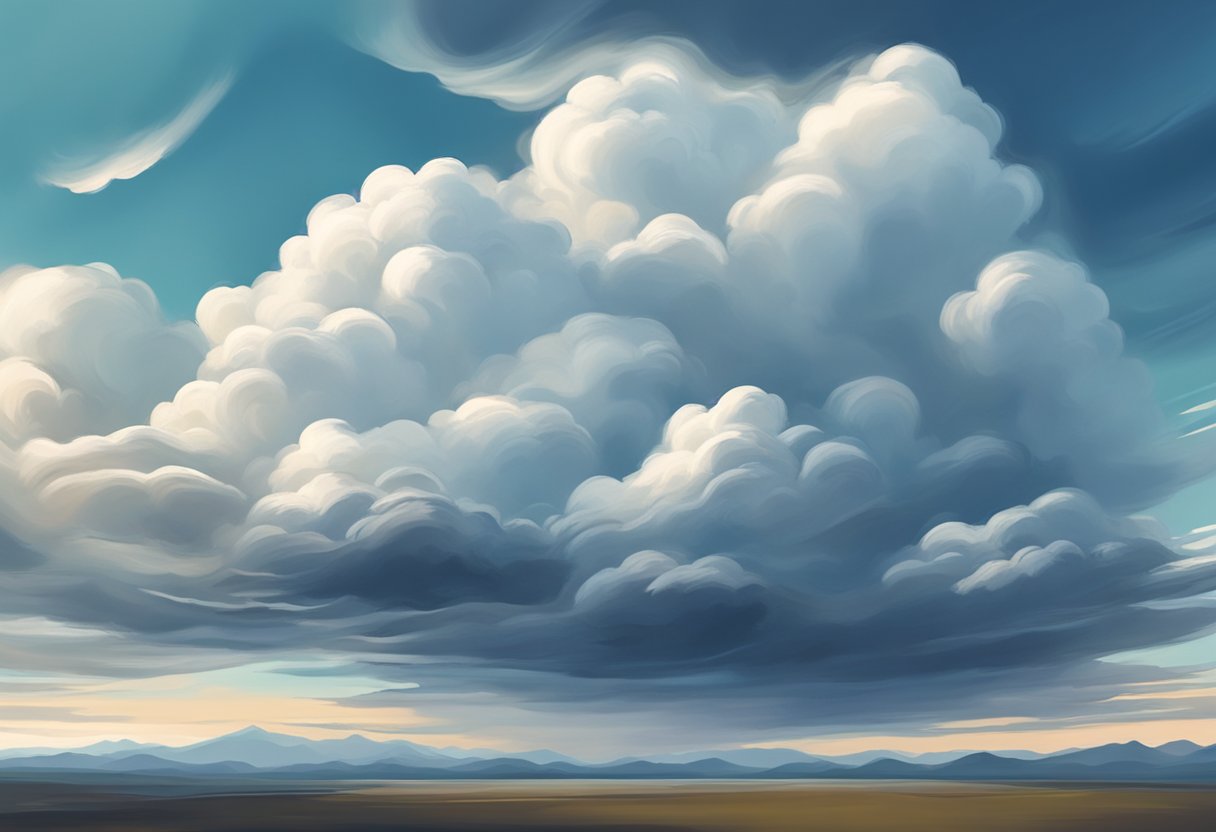Types of Rocks: A Comprehensive Guide to Identification and Classification
Explore the fascinating world of rocks with our guide on igneous, sedimentary, and metamorphic types and their formations.

Understanding the different types of clouds dotting the sky is akin to having a cheat sheet for predicting the weather. When you look up at the vast canvas above us, it’s not just about admiring the fluffy white shapes against a blue backdrop, but also about deciphering the story they’re trying to tell. Clouds are formed from water vapor that condenses into water droplets or ice crystals, depending on the temperature of the atmosphere. As you observe these floating wonders, remember that each type is a clue to the unfolding drama of the atmosphere.

The variety of clouds you see in the sky is sorted into categories based on their appearance and altitude. From the majestic cumulonimbus, with its towering anvil shape, hinting at thunderstorms, to the wispy cirrus clouds that feather the sky in high altitudes, each type offers a glimpse into the happenings within our planet’s atmosphere. By understanding these categories and their characteristics, you not only become a casual observer but also a connoisseur of the sky’s ever-changing moods.

When you’re gazing at the sky, have you ever wondered how clouds pop into existence? Well, let’s unravel the fluffy mystery together. Clouds are like nature’s mood rings, displaying the atmosphere’s emotions through their shape and fluffiness.
At the core of cloud formation is water vapor. This invisible gas is always hanging around in the air. When the conditions are right, this vapor decides to chill out, literally. As temperature decreases with altitude, water vapor gets cooler and may think, “It’s time to turn back into liquid.” This cool transformation act is called condensation.
Pressure also gets a VIP pass to our cloud party. It’s like the doorman to the sky club, determining how high or low clouds will form. Generally, the higher you go, the lower the pressure, letting clouds spread out and get comfortable.
Here’s a snapshot of the cloud lineup:
Sometimes, weather fronts like to crash the cloud party, shaking up things on the ground and pushing air upwards, leading to new cloud members joining the bash!
So next time you look up and see a cloud, you’ll know there’s a whole science behind their party in the sky. Don’t worry, no RSVP needed; you’re always invited to watch!

When you’re cloud watching, the sky’s the limit—literally! The types of clouds you’ll see are sorted based on how high in the troposphere they hang out. Keep your eyes peeled and read on to find out where to spot your favorite fluff balls.
High clouds are the cool kids on the upper block, typically hanging out above 20,000 feet. They’re made of ice crystals because at those altitudes, it’s too chilly for water droplets.
Meet the middle children of the cloud family, cruising at altitudes between 6,500 and 20,000 feet. Not as high-flying as their ice crystal siblings but not close enough to play tag with the mountains.
Down here under 6,500 feet, low clouds are often the ones you might think you could hop onto from your rooftop. Water droplets are the name of the game here, not ice.

When you look up at the sky, think of it as a giant tapestry of clouds, each variety telling its own story about the weather. They’re organized into families based on their appearance and altitude, so let’s unravel these sky-high mysteries together!
Cirrus clouds are the feathery, wispy members spending their days way up high, usually above 20,000 feet. Made of ice crystals, they’re the artists of the sky, drawing delicate patterns that can forecast a change in the weather. When sunlight hits them just right, they blaze up in a play of colors.
Meet the Cumulus family: the puffy, cotton-like clouds that inspire daydreams and doodles. They start out like fluffy cotton balls but can grow into towering Cumulonimbus clouds, the powerhouses known for their thunderous tempers and dramatic downpours.
Imagine pulling a thick blanket over your bed—that’s what Stratus clouds do to the sky. These uniform layers rarely make a scene but they’re the overcast day-makers. If you’re looking for a single grey shade to define the word “gloomy,” these clouds have got you covered.
Nimbostratus clouds aren’t here to party. They are the heavy-lifters, loaded with rain or snow and ready to let loose. Don’t expect fun shapes or sun shows from them; it’s strictly business with these clouds as they mean precipitation is en route. If it’s looking grey and your umbrella is handy, thank the nimbostratus.

When you look up at the sky, it’s like attending a vast art exhibit where clouds craft their masterpieces. They come in all shapes and sizes, from fluffy puffs to wide, sweeping bands. Let’s break down this sky gallery by their distinctive styles.
Ever seen clouds that resemble cotton candy? Those are the cumulus clouds, your classic ‘puffball’ ones. They’re the ones you loved to spot animal shapes in as a kid. Cumulus clouds generally mean good weather, so they’re like the cheerful folks at the party.
Now, the thin, wispy clouds way up high? Those are the cirrus clouds. Sometimes they streak across the sky in delicate bands, suggesting that change is afoot. If clouds were comic book heroes, cirrus clouds would be the ones with precognitive powers, hinting at the weather to come.
Picture clouds blanketing the sky like a cozy, gray quilt—that’s your stratus clouds. They bring the mood down a bit because they often result in drizzle. But hey, they’ve got size on their side, covering the sky in vast patches.
And if the sky suddenly looks dramatic, with clouds hanging down like pouches, those are mammatus clouds. Often associated with storms, they seem to roll on the underside of other clouds like a nature’s special effect.
Here’s a quick classification by altitude:
Lastly, if you see clouds that look like dark, menacing rolls, watch out! Those could be nimbostratus or cumulonimbus clouds, and they mean business—often bringing thunderstorms or heavy snow.
So, there you have it! The sky’s mood board catalogued and explained just for you. Next time you gaze upwards, give a nod to those natural wonders floating by.

Get ready to see the sky in a whole new light! Cloud gazing isn’t just about finding shapes of dragons or bunnies up there, it’s also about seeing the signs of what’s to come in the weather department.
When you spot clouds growing tall and turning into the hefty cumulonimbus type, you’d better pack an umbrella. These are the big guys that love to bring the drama with rain and snow depending on the season. Nimbus clouds are likewise drenched in moisture, and they sure aren’t shy about sharing it. So, when they’re around, precipitation is definitely on the agenda.
Now, talking about cold fronts and warm fronts, this is where clouds play the role of the sky’s messengers. A shift in your clouds from light and fluffy to thick and layered is like receiving a text message from “Weather Alert” that a cold front is near. Warm fronts, on the other hand, will often be heralded by high, wispy cirrus clouds. You’ll see these changes as the air mass swoops in with its own characteristic cloud entourage, letting you peek into the weather’s crystal ball.
Okay, here’s where things get electrifying – quite literally. When thunder grumbles and lightning splits the sky, the cumulonimbus clouds are running the show. Welcome to the thunderstorm party! These clouds tower up, reaching for the stratosphere, and have no trouble stirring up some serious weather action. If it’s one of those days where the clouds look like a dark, towering fortress, you might just be counting “one-Mississippi, two-Mississippi” till the next lightning strike!

When you’re looking up at the sky, keep in mind that clouds are classified by altitude, appearance, and the time of day you observe them. With the right techniques, you can spot the various cloud families and understand what they reveal about the weather.
From the comfort of your backyard or even a stroll through the park, you can witness the drama of the troposphere in action. You’ll spot cumulus clouds looking like fluffy, white cotton balls often signaling good weather but also possibly forming into larger towers, warning of storms if it’s your unlucky day.
Stratus clouds tend to cover the sky with a blanket of gray, making the day feel as if even your coffee needs a pick-me-up. Just remember, if these clouds decide to go full stealth mode and drop to the ground, you’ve got yourself some fog.
For those moments when you feel awe-inspired by streaks of color at dawn or dusk, thank cirrus clouds. High up in the stratosphere, these wispy, ice crystal-filled clouds paint the sky with hues that make you forget about the hustle of life for a moment. Be mindful, though; their presence often signals a change in weather, because they’re the trendsetters of the cloud world.
When touring near mountains, clouds often get a little show-offy, clinging to peaks in a way that makes you think they’re trying to snag a front-row seat to the best view.
Ah, satellites. These silent guardians in the sky are the go-to buddies of the World Meteorological Organization and NASA. Thanks to these high-flying tech wonders, you can snag real-time images of clouds from anywhere in the world while lounging in pajamas. They classify and track clouds like they’re collecting trading cards, offering valuable data on weather patterns.
Satellites give us the lowdown on clouds that are high up, like noctilucent or the rare polar mesospheric clouds which are found—well, you guessed it—at the poles and when the sun is below the horizon. A snapshot from a satellite may as well be cloud art, filled with stunning structures and breathtaking color palettes.
Cloud watching isn’t just a daytime activity. Those late-night or early-morning sky scans can reveal beauty like noctilucent clouds, which are thought to be made from the stuff of comets and are most visible when the sun is below the horizon, giving you a private cosmic light show.
The exclusive polar stratospheric clouds are found in winter near the poles and give off otherworldly iridescent colors. Remember, while daytime clouds come and go, these night-time spectacles require your patience and a bit of planning, but trust me, they’re worth the effort.
So there you have it: clouds are not just for daydreaming; they’re storytellers, meteorological messengers, and an ever-changing canvas that you can interpret. Keep your eyes to the skies, and you’ll be the most cloud-savvy person in the neighborhood.

Clouds aren’t just the fluffy, white things that occasionally ruin your picnics. They’ve been muses for poets and headaches for weather forecasters since, well, forever. Culturally, they’ve symbolized everything from divine omens to the creative bursts that give us lightbulb moments—to think, without clouds, where would our “brainstorms” even come from?
In history, clouds painted the stories of the gods thundering in the heavens. Fast forward a few centuries, and Luke Howard, an English pharmacist, was busy classifying these airy apparitions into groups like cumulus and stratus based on their characteristics. It turns out that clouds are not just handy for predicting if you should bring an umbrella, but also reveal the invisible patterns of our atmosphere.
Scientifically, clouds are the Earth’s way of showing off its water recycling program. They play a critical role in global heat distribution and are fundamental in the study of climate change. And let’s be honest, without clouds, meteorologists would feel lonely on TV, gesticulating at a painfully blue, empty sky.
So the next time you spot clouds, remember, you’re not just looking at water droplets or ice crystals; you’re witnessing science and culture playing patty-cake in the sky!

Let’s talk cloud measurements—it’s not as fluffy a topic as you’d think! To gauge these cottony figures in the sky, meteorologists use something called “total cloud amount,” which is basically a fancy way of saying, how much of the sky is decorated with clouds versus how much of it is still in its birthday suit, pure blue.
Alright, so how do you measure it? Imagine slicing the sky pie into eighths. These portions help experts quantify cloud coverage. Less than 2/8 is a sky on a diet (mostly clear), and over 6/8 is like the sky is feasting on clouds (mostly covered).
But wait, there’s more! You’ve got to consider the cloud’s VIP lounge—the altitude. Clouds hang out at different layers of the atmosphere, which is like their vertical lane. Cirrus clouds call dibs on the penthouse suite, lounging at high altitudes where the air is basically a freezer—super cold and dry. On the middle floors, you’ll find alto clouds, and the ground-floor residents are your stratus type, often bringing in that gloomy, overcast vibe.
Now, cloud formation doesn’t just happen. It’s like a recipe! Take some water droplets or ice crystals, mix ’em with dust, and when the temperature is just right—voilà! Clouds form in shapes only limited by your imagination.
Predicting their coming and going is an art form combined with science. By watching temperature changes, and how moist the air feels, meteorologists can often predict whether you’ll need sunglasses or if it’s a day to play “I spy” with shapes in the clouds. Just remember, even the best forecasts can have their heads in the clouds sometimes!

When you gaze up at the sky on Earth, it’s easy to think we’ve got the monopoly on clouds. But, surprise! Other celestial neighbors in our solar system know how to throw a cloud party too.
Venus: Imagine a thick blanket of clouds made almost entirely of sulfuric acid—yikes! These are eternally covering Venus, creating a super greenhouse effect.
Mars: You might find frosty clouds hovering over the Red Planet. These Martian marvels are made of water-ice and sometimes even carbon dioxide-ice. It’s like having dry ice floating in the sky, pretty cool (literally!).
Jupiter and Saturn: Talk about the ultimate gas giants with a flair for dramatic cloudscapes! Their decks of clouds are mostly ammonia, water, and methane. But, don’t let the pretty striped appearance fool you; it’s a rather unwelcoming place.
Uranus and Neptune: Brrr, think of these ice giants’ skies as the ultimate freezer. Methane clouds give them that charming blue-green tint. But you definitely wouldn’t want to get caught in a Neptunian methane cloud storm—those winds are no joke.
So next time you’re cloud-watching, remember that out there in the solar system, there’s a whole variety of clouds, each with its own extraterrestrial twist! No need for cloud envy, though; Earth still has some of the best cloud variety shows in the neighborhood.

When you wink up at the sky, you’re not just glancing through air; you’re ogling at the atmosphere’s mood ring—clouds! These fluffy sky-huggers do more than dot your Instagram sunset photos. Let’s break down their cool role.
Altitude Affects Attitude: Clouds at different heights show us the atmosphere’s layered wardrobe. High flyers like cirrus clouds, chilling above 20,000 feet, are mostly ice crystals. They’re the thin, wispy kind that sometimes hint at weather changes. Down below, stratus and cumulus clouds, lounging between the surface and 6,000 feet, tote water droplets around. They’re social butterflies, changing shape to suit the weather party below.
Precipitation Producers: Clouds are not just window dressing; they’re water movers. Whether spilling rain, sifting snow, or flinging hail, clouds distribute water like no one’s business, making them key players in the world’s water cycle.
Climate Chameleons: Here’s where they really flex. Clouds can be secret agents for both team warming and cooling. Reflecting sunlight back into space? Cooling effect badge earned! Trapping heat like a cozy blanket? That’s warming up the scoreboard.
Atmospheric Alchemists: By playing with sunlight and heat, clouds mix up the atmospheric recipe on the daily. Their coverage and composition can amp up or mellow out climate change—scientists call this feedback, and climate models are all hands on deck trying to crack their elusive code.
Remember this: Clouds aren’t just decorative; they’re downright environmental influencers setting the tempo for weather and climate. Stay tuned as they continue to ripple through the atmosphere, not just doling out rain checks but deciding Earth’s thermostat settings too!

Clouds are more than just fluffy sky decorations; they’re the mood rings of our atmosphere. Here’s a lightning round of cloud FAQs to lift the fog on these floating enigmas.
You’ve got clouds lounging at different VIP levels in the sky. High-level clouds chill above 20,000 feet and include the thin, wispy cirrus. Mid-level clouds like altocumulus hang out between 6,500 and 20,000 feet. Then the low-level ones, such as stratus, loiter below 6,500 feet. Exclusive to the mountaintops and sky-scrapers are the vertically gifted clouds, cumulonimbus, which can span multiple levels.
Sure can! There are four headliners in the cloud concert: cirrus, cumulus, stratus, and nimbus. Cirrus are those high and wispy creatives, cumulus are the fluffy, cotton-like bouncers, stratus serve horizontal, blanket-like vibes, and nimbus – well, they’re the rainmakers, often seen gatecrashing with precipitation.
It’s like cloud cosplay – observe the costume! Cirrus clouds are thin and whispy, and they love high altitudes. Cumulus clouds are your classic puffy, white clouds with flat bases. Stratus clouds? They’re the overcast, gloomy ones that cover the sky like a gray blanket. Then there’s nimbus or the cumulonimbus variety, towering with their anvil-shaped tops, ready to put on a thunderstorm show.
Cirrus clouds are the featherweights of the cloud world, appearing delicate and streaky high up in the sky. They’re made of ice crystals and tend to point in the direction of the wind at their altitude. Spotting them means you’re looking at a nice, clear day or possibly a change in weather in the next 24 hours.
When the sky goes dark and dramatic, it’s showtime for the cumulonimbus clouds. With their towering presence and menacing anvil-shaped tops, they’re the poster kids for stormy weather, packing a punch with thunder, lightning, and rain. Stratonimbus clouds also bring gloomy news, often delivering steady rain or snow.
Stratus clouds are like the cozy, overcast days made for coffee and books. They hover low, creating a featureless gray sheet across the sky, suggesting fair but dull weather. However, if they decide to touchdown, they transform into fog, making your morning commute as mysterious as a detective novel.